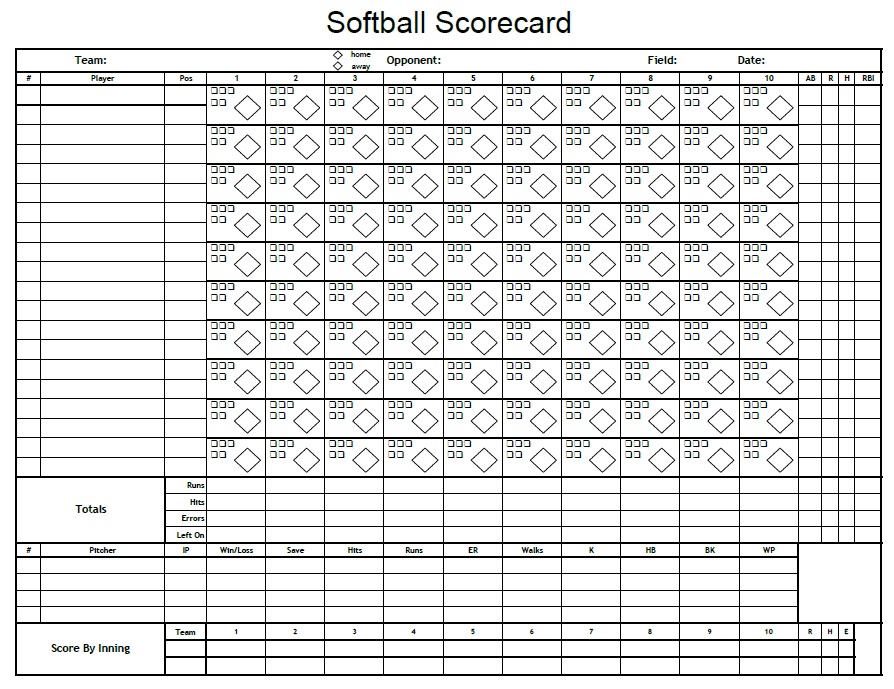Download these 13 Free Sample Softball Score Sheet Templates to help you design and print your own Score Sheet.
Softball is a very common and widely played game, and if you want to win this game or simply improve the way your team plays it, reading the game’s score sheet will provide a quick and easy way to view the entire game at glance and will give an opportunity to improve the weaknesses next time. No matter what your core purpose is, this scorecard can prove itself to be vital and important in many ways. Just know these simple and easy steps as the guidelines and you are just a pencil and paper away from your victory.
Contents
Step 1- Assign the tasks
Assign position numbers one to six to the pitcher, catcher, first, second, third baseman, and shortstop, respectively by writing their names on the left side of the sheet. Assign numbers seven to 10 to the outfielders, moving from left field to right. Alternatively, assign seven up to nine to the left, center, and right fielders, respectively, and give 10 to the rover, or short center fielder.
Step 2- jot everything down
Write everything that happens in an inning in the column with the appropriate number.
Step 3-write the activities
Record what is happening in the field in the way in which hitters reach base. Write “1B” for a single, “2B” for a double, “3B” for a triple and “HR” for a home run. If the sheet has symbols on it already, then circle the appropriate symbol. Try to comment on the mistakes of each player in the same manner.
Step 4 Mark the strike
Spot each strikeout with the note K. Write the K backward if the batsman takes a called third strike. Use symbols to save your time and use that energy to notice what your teammates are doing on the field.
Step 5 record the good and the bad
Notice and record all the positions that each of the players has taken. If any player catches the ball in the air, record it with a number 7. To distinguish between a line-drive-out and a pop-out on the infield, write “L” or “P” before the player’s number. If the player catches a foul ball, mention the letter F in front of the player’s name. Similarly, if a player hits a sacrifice fly, write “SF” before the player’s number. If the player hits a sacrifice bunt, write “SAC” before the fielder’s numbers.
Step 6 Mark the home run
Place a notation in a hitter’s box if she drives home a run. For example, if a player singles home a run, write “1B” in the middle of the box and place a dot in the upper-left corner to represent the RBI.
Step 7 Distinguish the innings
Draw a small diagonal line next to the lower-right corner of the last hitter’s box in each inning.
This thorough recording of the score and performance will help the team to improve the performance and working the weaknesses while strengthening the strengths and covering up the flaws.
Free Softball Score Sheet Templates
Here is a preview of This First Sample Softball Score Sheet Template in MS Word format.

Softball Inning Score Sheet Worksheet
File Type: PDF Format {ZIP File}
File Size: 48 KB

Fastpitch Softball Score Sheet Format
File Type: PDF Format {ZIP File}
File Size: 156 KB

Slowpitch Softball Score Sheet Sample
File Type: PDF Format {ZIP File}
File Size: 177 KB

Softball Player Stats Tracking Sheet
File Type: PDF Format {ZIP File}
File Size: 493 KB
Softball score sheets are essential tools used to record and track the progress and outcomes of softball games. They help in maintaining an accurate record of each player’s performance and the overall game statistics. Here are some common uses of softball score sheets:
Common Uses of Softball Score Sheets:
- Game Tracking:
- Recording Game Progress: Softball score sheets are used to document each inning, including runs scored, outs, hits, errors, and other significant events.
- Keeping Track of Score: They provide a clear and concise way to keep track of the score throughout the game.
- Player Performance Analysis:
- Batting Statistics: Track individual player statistics, such as at-bats, hits, runs, RBIs (Runs Batted In), home runs, and batting averages.
- Fielding Statistics: Record defensive plays, including putouts, assists, errors, and fielding percentages.
- Pitching Performance:
- Pitching Statistics: Document the performance of pitchers, including innings pitched, strikeouts, walks, hits allowed, runs allowed, and earned run averages (ERA).
- Team Strategy:
- Strategic Planning: Coaches and managers use score sheets to analyze the performance of their team and opponents, aiding in strategic planning for future games.
- Official Records:
- Maintaining Official Game Records: Score sheets serve as the official record of the game, which can be referred to for verifying game outcomes, player statistics, and resolving disputes.
- League Requirements: Many leagues require official score sheets to be submitted for record-keeping and playoff qualifications.
- Historical Data:
- Archiving Historical Data: Teams and leagues often keep score sheets as part of their historical archives, providing a record of past games and player achievements.
- Media and Reporting:
- Media Reporting: Journalists and broadcasters use score sheets to report accurate game details and player performances.
- Fan Engagement: Detailed score sheets can be shared with fans to keep them engaged and informed about game progress and statistics.









